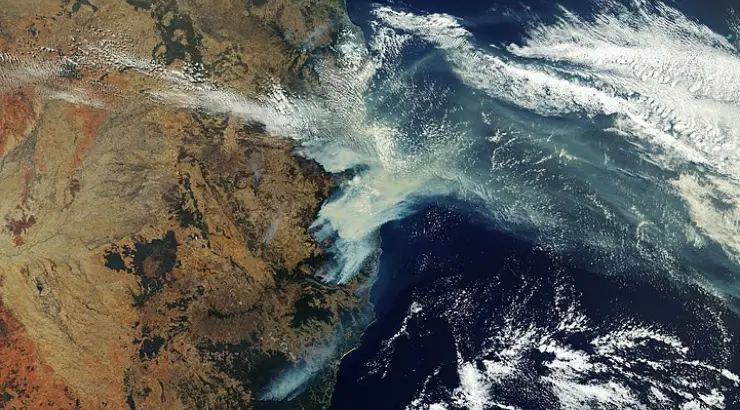News
Australians Flee as Soaring Heat, Gale Force Winds Cause Huge Flareup of “Megafires”
Fierce wind and soaring heat has caused six huge blazes to merge into two massive “megafires.”

(TMU) — Australia’s authorities urged nearly a quarter of a million people to evacuate their homes Friday as fierce wind and soaring heat slammed the country’s fire-ravaged southeast regions, causing huge blazes to merge into massive “megafires”—including one measuring over 1.5 million acres (over 630 thousand hectares), roughly eight times as large as New York City.
The massive flare-up came when a week of relative calm halted Thursday night as the heat, dry conditions, and erratic winds reaching over 55 miles (90 km) caused six bushfires in two Australian states to merge, resulting in the formation of two emergency-level “mega-blazes,” reports Wildfire Today.
Authorities are warning that the day will be “very, very challenging” despite the presence of rainfall in some regions, according to Reuters.
Military personnel stand ready to intervene in case the bushfire reaches extreme levels, Prime Minister Scott Morrison said. However, authorities aren’t taking any risks, and 240,000 people in Victoria have been notified via emergency text to flee. In the meantime, residents of high-risk regions in New South Wales (NSW) and South Australia have also been told to consider evacuation.
All hail our new mega-blaze overlords! pic.twitter.com/KSxgF3rgOP
— thesaurically depleted pup (@LizDolphinfluff) January 10, 2020
Daniel Andrews, the premier of Victoria, said in a press conference that residents should remain on high alert. He said:
“Even with rain in Melbourne, even with forecast better conditions next week, there is a long way to go in what has been an unprecedented fire event…and, of course, we know that we have many weeks of the fire season to run …The next few hours are going to be very, very challenging.”
Since the fire crisis broke out in September, at least 27 people have been killed and countless others forced to evacuate—often repeatedly—as the historic wave of bushfires ripped through 25.5 million acres (10.3 million hectares) of land, an area equal to the size of South Korea.
The NSW Rural Fire Service confirmed Friday that a total of 2,000 homes have been destroyed since the crisis began, including 1,079 since January 1.
While the winds are expected to subside on Saturday, the bushfires have proven capable of generating their own brutal weather conditions in the form of pyro-cumulonimbus clouds, or dry thunderstorms that create more fires and add an unpredictable dynamic to the spread of the fires. NASA describes the phenomenon as the “fire-breathing dragon of clouds.”
Authorities warn that the huge fires, stoked by a continuing heatwave, winds, and arid conditions resulting from a three-year drought, could persist for months until the country sees substantial rainfall, which remains a remote possibility in the next few months.
So far, the fires have emitted 400 megatons of carbon dioxide and produced harmful pollutants, the European Union’s Copernicus monitoring program said.
Wildfire risk increases with global warming.
Megafires are accelerated by high temperatures & drought. And they are extremely challenging to contain, usually only limited by the amount of available burnable vegetation. #ClimateCrisis https://t.co/ZTfyb07V3x
— UN Environment Programme (@UNEP) January 10, 2020
Massive smoke plumes visible from space have also drifted across the Pacific, affecting regions as distant as South America and even potentially Antarctica, according to the U.N. World Meteorological Organization.
Ecologists at the University of Sydney estimate that over 1 billion animals have been killed in the bushfires, potentially destroying ecosystems and forever tipping the balance for whole species.
The nightmarish extent of Australia’s wildfires is clear when comparing the blaze with other recent catastrophes. Since the Australian bushfire crisis broke out, the amount of burnt terrain in the island continent is more than twice that in the similarly horrific fires in Brazil, California, and Indonesia combined.
By Elias Marat | Creative Commons | TheMindUnleashed.com
Typos, corrections and/or news tips? Email us at Contact@TheMindUnleashed.com
